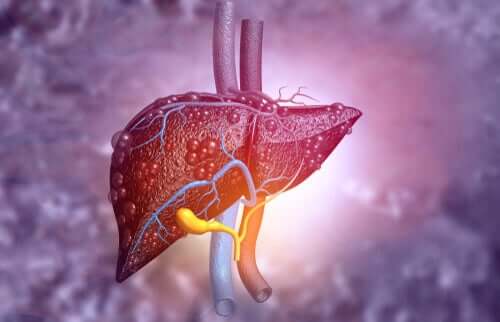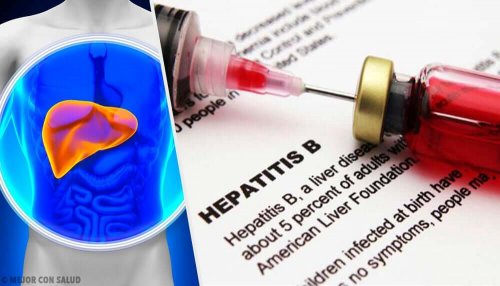Learn All about Liver Diseases

All liver diseases require medical attention because they affect a vital organ. The liver plays a role in the digestion of food, stores energy, and releases toxins. That’s why several liver diseases can even lead to death.
Liver diseases are caused by various factors. Sometimes, they’re caused by viruses. Other times, they’re due to the ingestion of a toxic substance. Only rarely are they due to hereditary reasons. Overall, symptoms of liver diseases vary widely depending on the condition the patient is suffering from. However, in some cases, they cause no symptoms and are only detectable by laboratory tests.
In this article, you’ll discover the main liver diseases.
Nonalcoholic fatty liver disease (NAFLD) and nonalcoholic steatohepatitis (NASH)

Nonalcoholic fatty liver disease (NAFLD) is characterized by an accumulation of lipids in the liver. Also, if there’s also inflammation and injury of liver cells, it’s called “nonalcoholic steatohepatitis” or NASH. Obese people who have type 2 diabetes and those with metabolic syndrome are more likely to develop these diseases.
Usually, these diseases don’t manifest with symptoms.
Cirrhosis, one of the most serious liver diseases
Cirrhosis is one of the most serious liver diseases. This disease causes scar tissue to replace healthy tissue. Thus, the liver is scarred and permanently damaged, meaning it can’t function well.
There’s no specific treatment for cirrhosis. However, there are treatment options for the causes that produce it. The most common causes of cirrhosis include:
- Alcoholism.
- Nonalcoholic fatty liver disease (NAFLD).
- Chronic hepatitis C.
- Chronic hepatitis B.
Keep reading: Improve Your Liver Health with a Simple Remedy: Boldo
Autoimmune hepatitis
Autoimmune hepatitis is a chronic disease that occurs because the immune system attacks the liver. Consequently, it causes inflammation and damage. If the person with this disease doesn’t receive proper treatment, it can progress and cause liver cirrhosis.
Autoimmune hepatitis is one of the liver diseases that sometimes doesn’t produce any symptoms at first, although it does so over time. Medical professionals diagnose the condition based on the patient’s medical history. Also, they’ll need to request certain tests.
Hepatitis A, B, and C

Viruses cause these conditions. Hepatitis A causes inflammation. This, in turn, causes the liver to not function properly. It spreads through contact with the fecal material from a previously infected person.
In turn, hepatitis B has similar characteristics. However, in this case, it spreads through contact with any of the body fluids of an infected person. There’s an acute and a chronic form. Without treatment, the latter can turn into liver cancer or cause liver failure.
Hepatitis C has a pattern similar to the previous two. However, it spreads via contact with the blood of an infected person. Early symptoms may manifest up to 10 years after infection. Just like type B, it has an acute and chronic form.
Find out more here: 9 Properties of Wormwood for Liver Health
Hepatitis D and E
The hepatitis D virus is very rare and only affects those with hepatitis B. When both hepatitis B and D viruses affect a person, doctors refer to this as a “coinfection.” If the person has chronic hepatitis B and then becomes infected with hepatitis D, doctors refer to this as a “superinfection.”
Hepatitis E spreads by drinking water that has been contaminated with the feces of an infected person. Also, it can be caused by eating undercooked pork or wild game. Usually, it subsides after a few weeks without treatment. Due to unknown causes, this disease has a 20% mortality rate in pregnant women.
Other liver diseases
Iron overload isn’t a specific liver disease, but it does affect it significantly. This condition is characterized by excessive iron buildup in the body. Thus, it can cause liver fibrosis and 60% of patients develop cirrhosis. Overall, 5% of cases lead to the development of malignant tumors.
On the other hand, Wilson’s disease is a rare inherited disorder that doesn’t allow the body to naturally rid itself of the copper it doesn’t need. If copper accumulates in the liver, it may lead to cirrhosis.
Hepatitis B and C, as well as cirrhosis, iron overload, excessive alcohol intake, obesity, and diabetes, are risk factors for developing liver cancer. Currently, there are several available treatments to fight it. In conclusion, you mustn’t underestimate your symptoms and consult your doctor as soon as they manifest to prevent complications.
All cited sources were thoroughly reviewed by our team to ensure their quality, reliability, currency, and validity. The bibliography of this article was considered reliable and of academic or scientific accuracy.
- Beltrán, M. D. L. L. M., Ruiz, L. H., Velázquez, A. L. L., & Cerda, A. P. (2005). Fitoterapia molecular como parte de la medicina alternativa complementaria en las enfermedades del hígado. Investigación en salud, 7(1), 64-70.
This text is provided for informational purposes only and does not replace consultation with a professional. If in doubt, consult your specialist.








